
The Bolivian border from Peru | Our practical guide and more
The Bolivian border crossing was quite a pleasant surprise, we had been expecting it to be a little tricky but it turned out to be a quite simple process.
If you’ve ever looked at visiting Bolivia then I suspect that doing some kind of Bolivia Salt Flats tour will be at the top of your itinerary. After all it’s one of the most incredible landscapes on the planet and a must see. But where do you start when looking for a tour? In this post we will share our experiences and try and explain your choices and some of the pitfalls when booking your tour.
We will also give you an insight as to what to expect on your chosen tour, when it the best time to go, the good and the not so good aspects. Yes, it’s a wonderful place to visit and if you prepare well and get the logistical things right you will have a wonderful experience that will stay with you for the rest of your life.
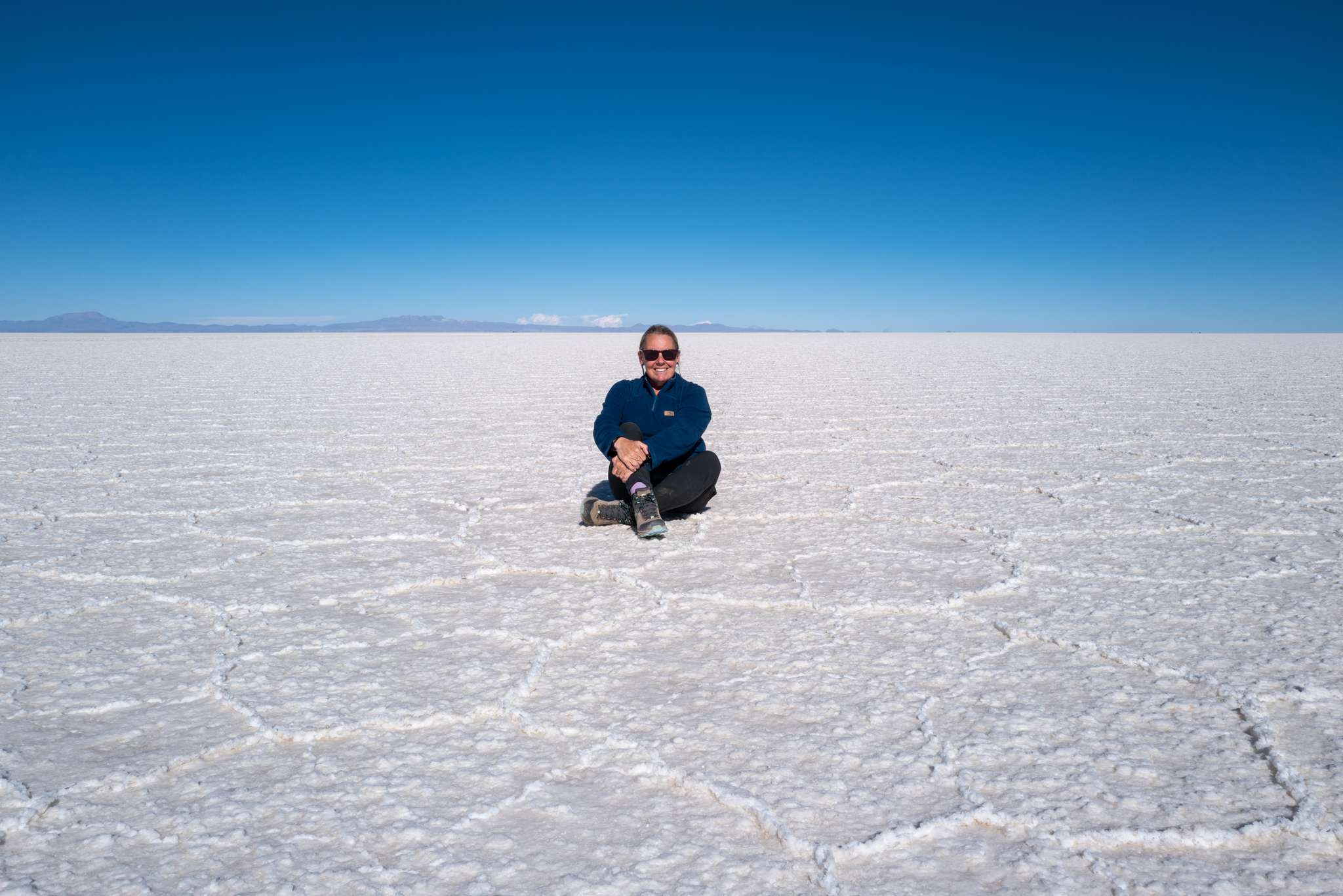
Salar de Uyuni, as the salt pan, is known in Spanish sits in the south west of Bolivia close to the border with Chile. It is all that’s left of a prehistoric inland sea that once covered the entire altiplano or high plain. As the water evaporated it left behind a thick layer of salt which, in some areas, can be as thicks as ten metres and stretches across more than 10,000 square kilometres and is ever expanding.
The salt is harvested from the flats and is used as table salt and is also used as a building material when extracted in blocks. The real treasure however lies beneath the salt crust, it is believed that underneath up to seventy percent of the worlds Lithium resources can be found which would make Bolivia one of the riches countries on the planet. Hopefully the extraction of this valuable commodity will not spoil the amazing beauty of this stunning and important landscape.
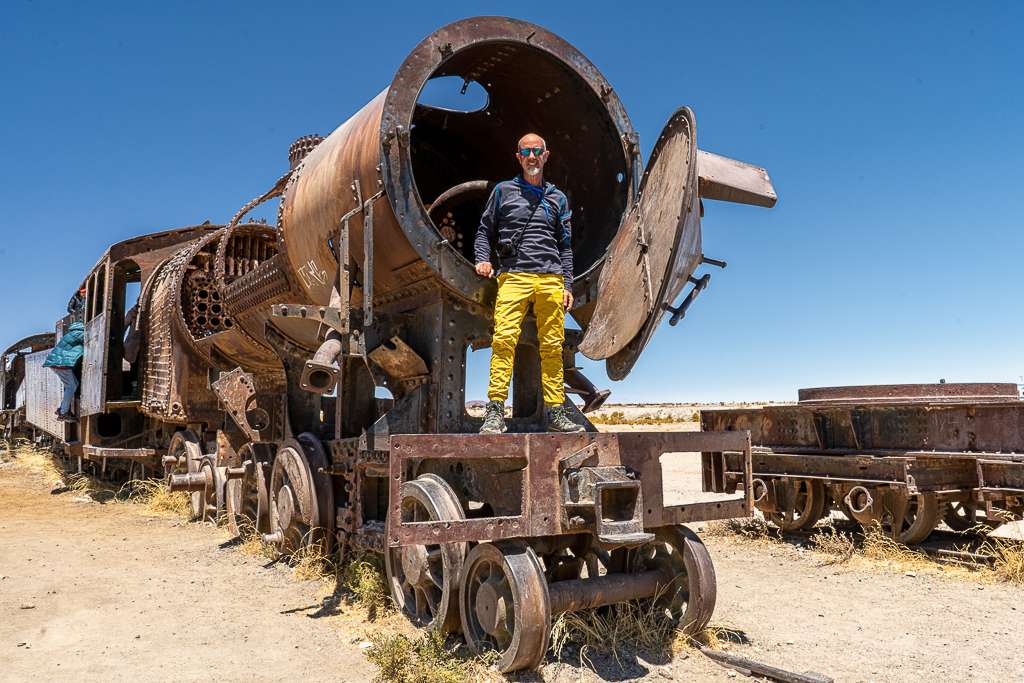
For simplicity this post will concentrate on the three day, two night tour out of the town of Uyuni in Bolivia. This is the tour we did so it’s the one we can give good advice about. There are however quite a few variables to consider depending on how much time you have, where your starting point is, what you want to see and where you want the tour to finish. Our tour started in Uyuni and was the regular three days and two nights with the option to either come back to Uyuni or cross the border into Chile at the end of the tour.
We choose the most common package for the multi day tour of three days with two nights in hostels. There are however other options from one day trips to four days and three nights. The one day trips are limited to just the salt flats and returning to your starting point in Uyuni. It’s basically the same as the first day of the three day tour but you get to see a little bit more of the salt production process.
The four day tour includes an extra day on the salt flats with a visit to Tunupa Volcano This is the tour we originally wanted to do but we found the cost to be very expensive and the logistics to be quite complicated. The tour we were offered came back to Uyuni after the first day which we didn’t really want to do.
There is also the option to do a two day tour if you’re short of time. We didn’t investigate this option as we had enough time to take the longer tour so we don’t have a lot of information for you on this one. However it seems to be two days on the salt flats as apposed to the three day tour which spends one day on the flats then visits various Lagunas.
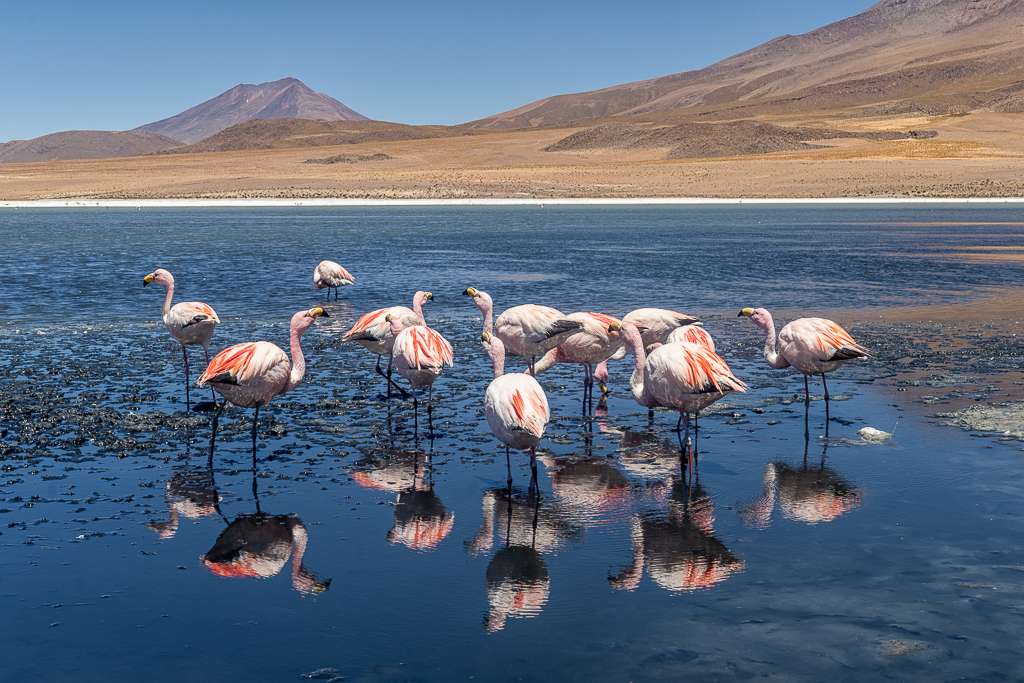
The third choice we will cover is to book in person in Uyuni either the day before which will involve and extra night in the town before the tour. You could however save yourself this cost by going to book straight off the night bus from La Paz which is what a lot tend to do as you get into town at around 5am and the tours go between 10 and 11am. We found this to be a little too much for us so choose to spend the first night in Uyuni. We stayed a night in Uyuni at Piedra Blanca Backpackers Hostel which did us fine for the one night. We paid extra for the early check in and got the room straight away at 5am when we arrived.
All the tour operators offices are on the Main Street within a few blocks of each other. We had done some research online and chose three companies we thought offered what we were looking for. At this point this was a four day tour. We soon found out that for us this wasn’t going to work, so quite quickly switched to three days. This made it easier as all the tour operators had this option going very day. As we said we had already done some research but having visited the three companies we had chosen none seemed to offer what we wanted at the price we were looking for.
With hindsight we got lucky, we saw two of the companies we had considered on the flats with multiple trucks in big groups and were very pleased with what we ended up booking. We chose Cordillera Traveller or should I say they choose us, a very nice young lady came bounding out of her office with amazing enthusiasm saying she had two places left in a single truck with an English speaking guide. After half an hour chatting with her we knew this was the one for us the price was right and the attention to detail seemed good. We did however have to pay cash there and then. There are a number of cash machines in the town but only one that didn’t charge us for withdrawals. Mercantile Santa Cruz. It may not be the same for all cards but its worth a try.
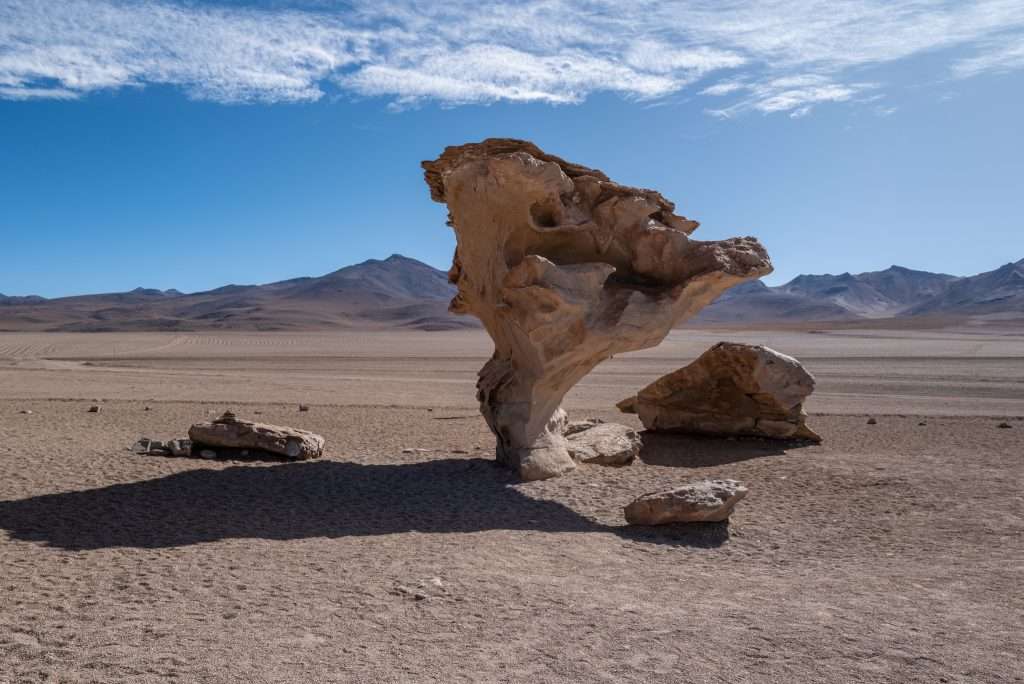
It was November when we did the tour so this is a description of a dry season three day, two night tour from Uyuni and finishing in San Pedro de Atacama. All the tour operators have slightly different ways of doing the tour and different standards of accommodations. This is an account of our experience and may not be the same as you get. We will be honest with our description as we want you to get a true opinion.
The first day for us started with a pick up from our hostal at about 10.30am, then back to the office to pick up the other three on our tour. We should have been six which is the usual number in each vehicle but we had a cancellation so we had a little bit more room for our day bags. As all five of us in the car where crossing the border into Chile all the big ruck sacks were loaded on the roof for transportation. If you’re coming back to Uyuni you can choose to leave your unneeded luggage in the tour office and pick it up on return.
The first stop is the train graveyard where several large locomotives and coal wagons have been left to disintegrate. It looks a bit of an eyesore but its fun to clamber around on the old machinery and get some pictures. This is also where you find out the scale of the tour operation, as there are about thirty more vans each with a full load, all vying to get that perfect picture. We spent about thirty minutes here, which is easily long enough. The convoy then races off to the next stop.
Next we are driven out into the middle of nowhere and at last we appear to be alone. Each tour car seems to have their own piece of pristine salt to do the photos. Walter our guide and driver had all the props and he turned out to be a wonderful director of photography. Over the next hour he arranged us all into the perfect poses to produce those amazing perspective photos you must have seen whilst doing your research
This turned out to be much more fun than I thought it would be, we had a good bunch and were beginning to get to know each other an although they we much younger than us we all seemed to get on well during the process of producing the pictures. We even managed a couple of really cool videos.

Next stop was one of the many islands in the salt, I believe there are over thirty. These islands are home to giant cacti, Isla Incahuasi, 30 bob entry not included in the tour price, was the one we stopped at. For the price you get to climb to the top past all the cacti and look out over the salt which is a fantastic view. Included in the price is a free visit to the toilet which is a welcome relief.
The last stop of the day and the last stop on the salt flats is watching the sun go down with a glass of Bolivian red wine which was a very nice surprise. The sunset wasn’t spectacular but that’s the luck of the draw, it was however a very nice few minutes taking in our last view of the salt.
We drive through the desert wildlife spotting. Plenty of Vicuñas can be seen grazing on what ever they can find and we were also lucky enough to spot two rheas feeding in a ploughed field. Quinoa is the staple crop here in the desert and our first stop of the day was a make shift museum dedicated to the crop. We got a quick educative talk from Walter our guide then off we went again to our next stop.
The railway lines from Uyuni still carry cargo trains through to the coast in Chile. The coastal part of Chile used to belong to Bolivia until it was lost in the Saltpeter war between 1879 and 1884. Our only interest in the track was to pose for more pictures, the track runs straight across the desert to the horizon. After a short stop we are on our way to a mirador which looks out to one of the many big volcanoes. We are promised a Llama sausage but the man hasn’t delivered that day so we have to do without. There are toilets though at the standard price.
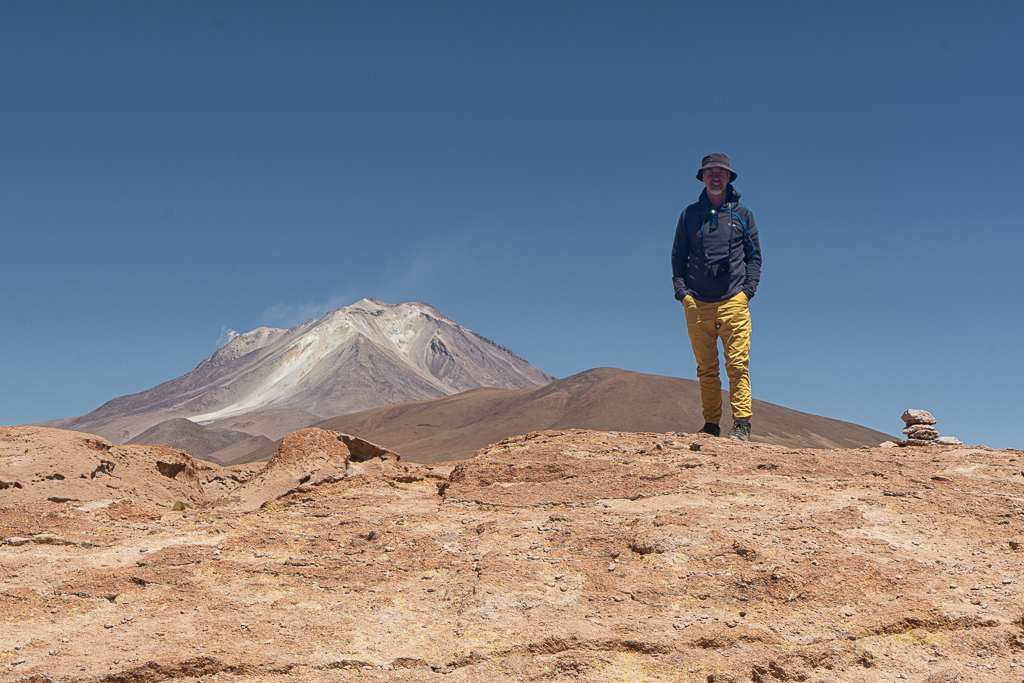
With the promise of Viscachas, a kind of cross between a rabbit and a kangaroo, we are off on our way again. At first it’s not apparent we will see the wildlife, but then as our eyes get used to the colours we start to see them. They are a little bigger than a normal rabbit with long black whiskers, quite tame, it seems they are used to seeing us tourists. They will even take apple from your hand but we try not to interact that closely, it’s not good for them in the long term.
The rock formation that resembles a tree is next, it’s not really as we expected, smaller and not on it’s own as you see in so many of the pictures. It is an interesting shape and from the right angle does look tree like. There are signs asking you not to lean on it as it is loosing it’s fight with the wind and looks like it may tumble over at any minute.
Next is the Red Lagoon, we had been looking forward to this but first the park fee’s. It’s 150 BOB per person to enter the national park. There’s a rangers station just before the lake where you hand over the money. You need to keep this ticket very safe as you will need it on the last day. If you loose it you will need to pay again.
We were lucky with the conditions as the lake was quite red. From the view point you can walk down to the shore to get a better look. There are an estimated 10,000 Flamingoes making their home on the lake in peak season. The lake is quite big though and they are spread out over a large area so we didn’t try counting them.
It’s getting late in the day now and our last stop is the Geyser fields. From a distance these don’t look very impressive but as you get closer and start to smell the sulfur, hear the hiss of steam and bubbling of the mud pools it gets quite interesting. There’s no health and safety measures here, just a warning from our guide not to get to close to the edges of the pools and don’t touch anything.
From here we go to our lodging for the night, we had paid extra for a private room with a hot shower. This is not included in the cost of the tour if you don’t book the room its dorm style accommodation. Dinner was again not as good as the lunch and we were shattered so another early night was called for. The three others on our tour took the option of a relaxing dip in a thermal pool down by the shore of the lagoon. Again there’s a small extra charge for the privilege.
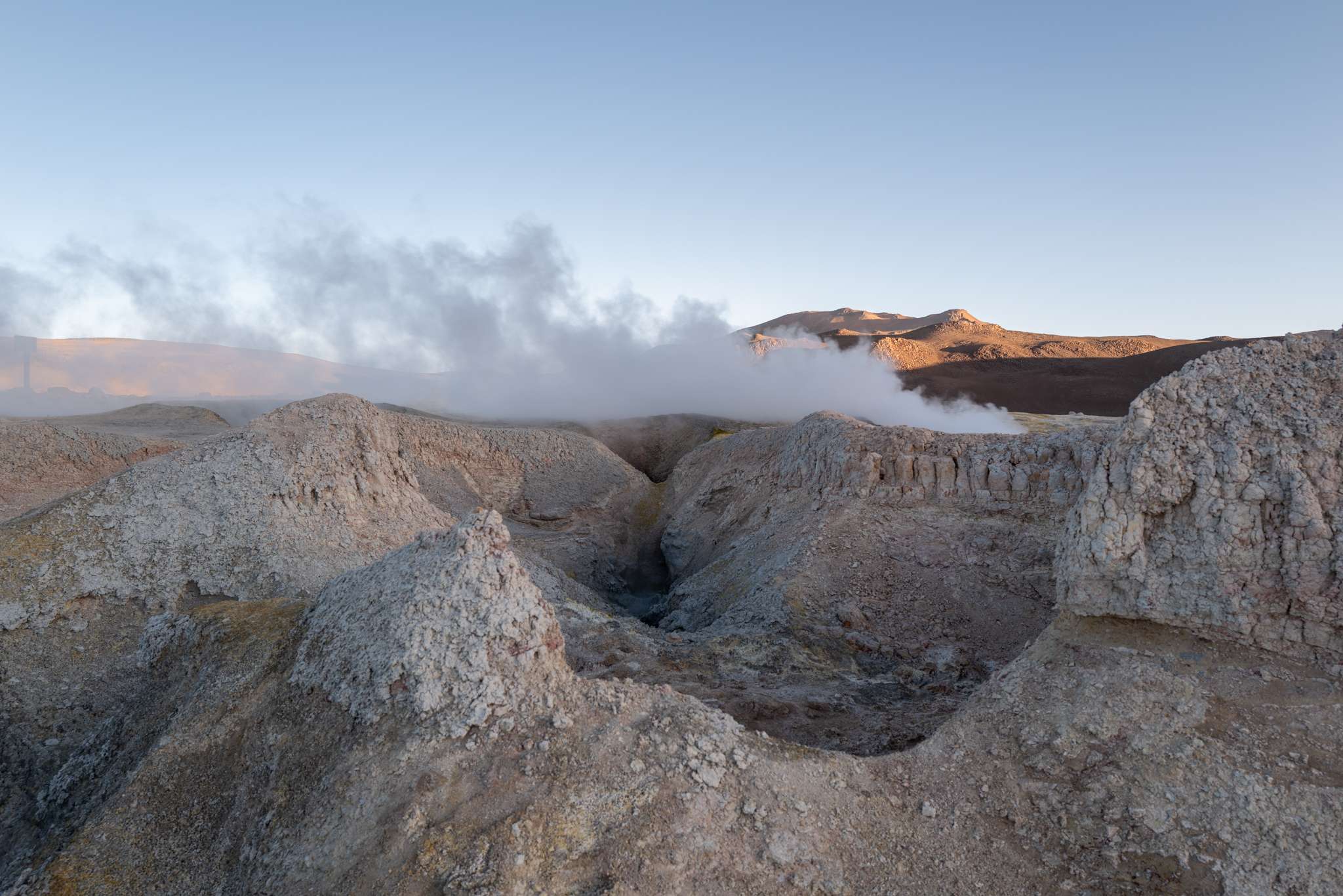
If like us you’re heading over the border into Chile the last day is quite short. After a quick breakfast we are on our way at 7.30am. Two more colourful lagoons to visit before the crossing, green and white. For us these were the most picturesque the wind had dropped which made for beautiful pictures with the green colour becoming more clear as we watched.
First job is to show your National park ticket to exit, then it’s into the Bolivian immigration hut to get your passport stamped. Here you have to pay the man 15 BOB, we couldn’t get an answer as to why, but if you don’t pay you don’t get stamped. Once that’s done we are driven to a carpark where there’s a minibus waiting to take us to San Pedro, this is included in the price of the tour.
On the bus you’re given a form that you need to fill in as you are driven to the border control. Instructions are given on the bus in Spanish only so we were not too sure what will happen. We are ushered off the bus and as we queue to get our passports stamped we are asked to show our proof of covid vaccination. Our passport is stamped without any issues and our bags are quickly searched and before you know it we are all back on the bus heading down into the oasis town of San Pedro.
In our opinion this is something that must be done in one way or another. It’s the star in the crown of the Bolivian experience. If you can, don’t book until you get to Uyuni. If you only want to see the salt flats themselves a one day tour covers everything and more than you get on the three day tour. Don’t expect to be the only tour out there, the first day is very busy with other tourists doing the same thing as you.
Don’t forget to shop around, do some research and make sure you know what you want before you go looking. All the tours follow the same basic route, there is very little difference between a so called luxury tour and the normal priced tour. The most important thing to remember when booking is check out the car if you can . Some are old and can be cold and draughty. All the companies will try and advise you to hire a sleeping bag if you don’t have one. When we went we didn’t need one both the rooms were warm enough with just the provided blankets.
One more thing to remember, this is a high altitude tour at well over 4000m make sure you’re acclimatised before you set off. La Paz is a high altitude city so if you’ve spent time there before your trip with no effects of sickness you should be ok.
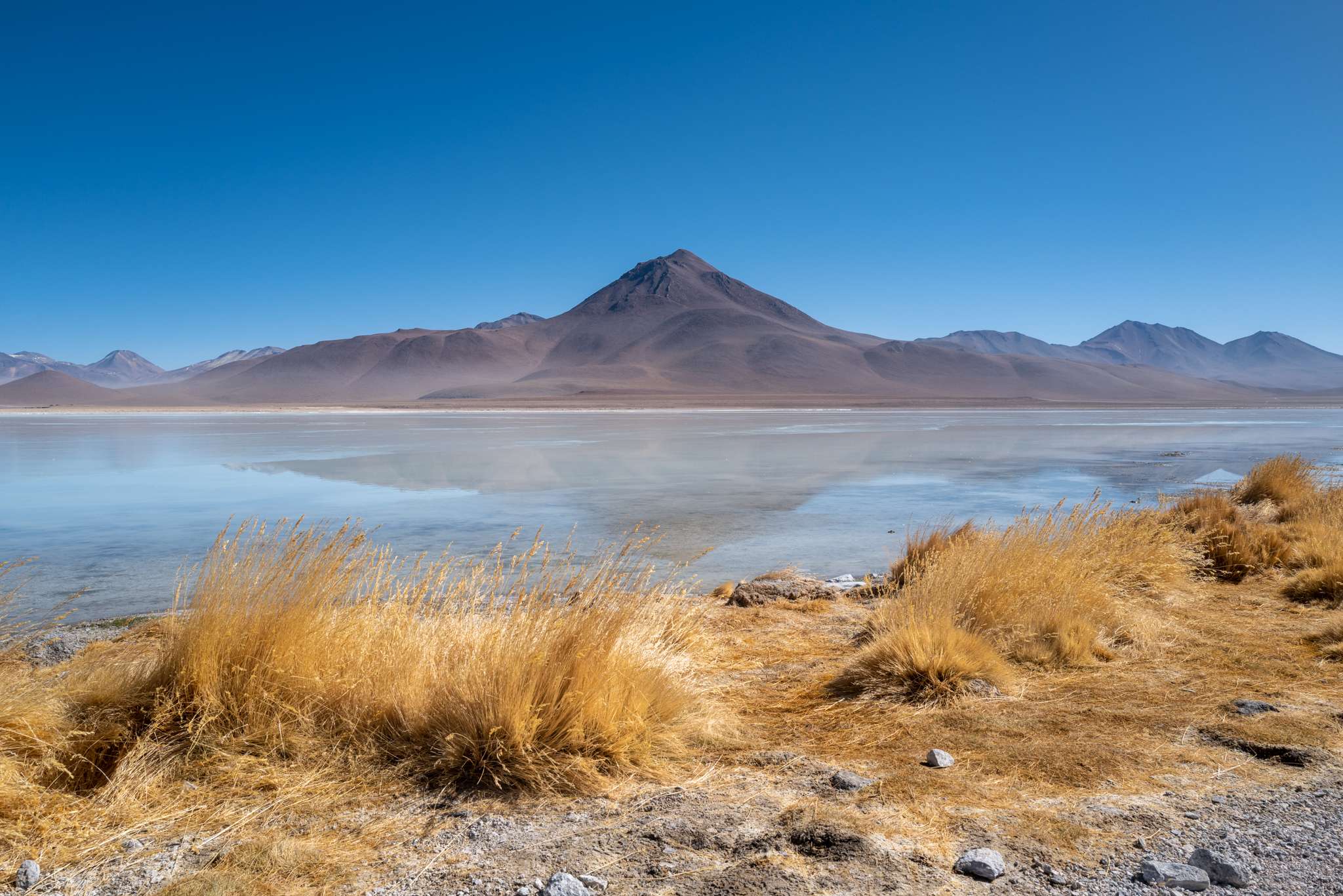
You can compare cheap flights on the Expedia platform or here on the Aviasales website. Both will give you a good idea of how much its going to cost you to get to your chosen destination.
We have always tended to use Booking.com having said that if your on a tight budget another good site to try as a comparison is Hostelworld, If your looking to compare different sites you can do that on Hotellook, we tend to look on here first to make sure we are getting the best deal.
You can book your visits as you go at the entrance to your chosen attraction or site. Or you could use the following links to book in advance or just to find out what your choices are in the area. GetYourGuide and Tiqets are our go to choices you could try Viator to see how they compare.
For a full list check out our resources page. Don’t forget always shop around to find the best deal for you. What works for us should be good for you but it’s always reassuring to check.
Some of the links on this page contain affiliate marketing links, which means we may get paid commission on sales of those products or services we write about. You will never be charged a fee for shopping through one of our affiliate links. You may even get a discounted rate and we will make a small commission. Our editorial content is not influenced by advertisers or affiliate partnerships.

The Bolivian border crossing was quite a pleasant surprise, we had been expecting it to be a little tricky but it turned out to be a quite simple process.
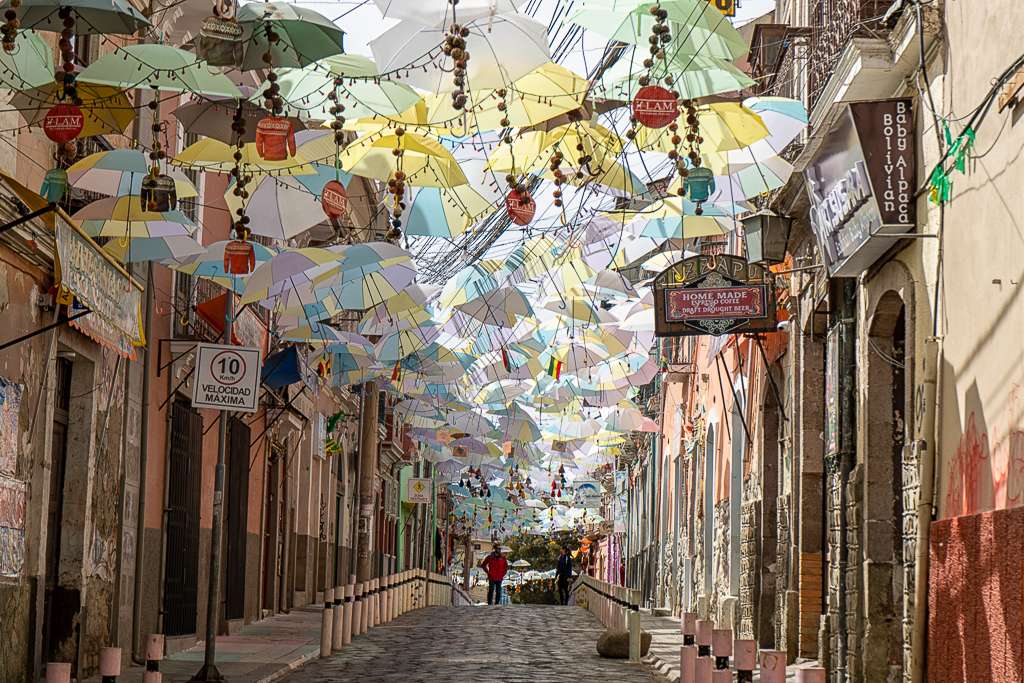
When you think of La Paz Bolivia most people tend to think this is the capital of Bolivia, I know I did, but in fact its only the administrative capital with the true capital of the country being Sucre.

When your sat watching rubbish on the telly and someone says, only aliens could have created such intricate patterns your interest peaks.
Error: No feed with the ID 3 found.
Please go to the Instagram Feed settings page to create a feed.
@Andiamo Amigos 2020 – 2022
All rights reserved. Photography and written content may not be reproduced without our permission.
| Cookie | Duration | Description |
|---|---|---|
| cookielawinfo-checkbox-analytics | 11 months | This cookie is set by GDPR Cookie Consent plugin. The cookie is used to store the user consent for the cookies in the category "Analytics". |
| cookielawinfo-checkbox-functional | 11 months | The cookie is set by GDPR cookie consent to record the user consent for the cookies in the category "Functional". |
| cookielawinfo-checkbox-necessary | 11 months | This cookie is set by GDPR Cookie Consent plugin. The cookies is used to store the user consent for the cookies in the category "Necessary". |
| cookielawinfo-checkbox-others | 11 months | This cookie is set by GDPR Cookie Consent plugin. The cookie is used to store the user consent for the cookies in the category "Other. |
| cookielawinfo-checkbox-performance | 11 months | This cookie is set by GDPR Cookie Consent plugin. The cookie is used to store the user consent for the cookies in the category "Performance". |
| viewed_cookie_policy | 11 months | The cookie is set by the GDPR Cookie Consent plugin and is used to store whether or not user has consented to the use of cookies. It does not store any personal data. |